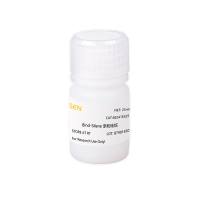Searching, Viewing, and Visualizing Data in the Biomolecular Interaction Network Database (BIND)
互联网
- Abstract
- Table of Contents
- Figures
- Literature Cited
Abstract
The Biomolecular Interaction Network Database (BIND) comprises data from peer?reviewed literature and direct submissions. BIND's data model was the first of its kind to be peer?reviewed prior to database development, and is now a mature standard data format spanning molecular interactions, small molecule chemical reactions, and interfaces from three?dimensional structures, pathways, and genetic interaction networks. BIND supports additional file formats to achieve compatibility with other database efforts, including the HUPO PSI Level 2. BIND's latest software spans over 2000 metadata fields and is constructed using the Java Enterprise Systems software platform. Protocols are provided for searching BIND via the Internet, as well as for viewing and exporting search results or individual records. Furthermore, a protocol is provided for visualizing biomolecular interactions within BIND or for transferring this information to the visualization tools Cytoscape and Cn3D.
Keywords: BIND; molecular; interactions; database; pathways
Table of Contents
- Basic Protocol 1: The BIND Interface: Getting Started
- Basic Protocol 2: Searching BIND Using Text Queries, Identifier Function, or Molecule Short Label
- Basic Protocol 3: Searching BIND Using the Field‐Specific Function
- Basic Protocol 4: Searching BIND by Sequence: BINDBlast
- Basic Protocol 5: Searching BIND by Browsing the Statistics Page
- Basic Protocol 6: Viewing BIND Search Results
- Basic Protocol 7: Viewing Interaction Records
- Basic Protocol 8: Exporting BIND Search Results for Use with Other Software
- Basic Protocol 9: Visualizing Interactions Using the BIND Interaction Viewer (BIV)
- Basic Protocol 10: Exporting BIND Interaction Data for Viewing with Cytoscape or Cn3D
- Commentary
- Literature Cited
- Figures
- Tables
Materials
Figures
-
Figure 8.9.1 The BIND home page accessed via a WWW browser at http://bind.ca. View Image -
Figure 8.9.2 Multiple methods for querying BIND. (A ) Text Query (see ) with options expanded by clicking the [+] symbol (note that this has changed to [–] here). Options are provided for limiting the query to specific types of interactions or to specific BIND divisions organized as branches of the taxonomy tree. One can also choose to filter out redundant records and change the number of records per page. LTP refers to hand‐curated records, HTP are high‐throughput records. (B ) Identifier Search (see ) with pull‐down list of over 40 different databases. Example here uses an NCBI GenInfo (GI) number. (C ) Text search box (see ) from the BIND home page showing the syntax for a field‐specific query for a molecule short label. (D ) Field‐Specific query dialog box (see ) showing the expanded field‐name list box from which database fields may be chosen. (E ) BINDBlast (see ) provides a sequence‐similarity based query interface for BIND. (F ) BIND Statistics (see ) are convenient for quickly finding relevant subsets of BIND records which can be browsed by clicking on the spectacles icon. View Image -
Figure 8.9.3 Summary of BIND results from simple text query for huntington. View Image -
Figure 8.9.4 Molecule‐centric summary of BIND results from GI query for huntingtin. View Image -
Figure 8.9.5 Creating a field‐specific query in this case used to search for a protein with a specific name from a specific organism. Recent queries are expanded in a list at the bottom right‐hand corner of the dialog box. View Image -
Figure 8.9.6 Overview of BINDBlast results. The sequence alignments are truncated in the figure for clarity, but can be seen by scrolling down. View Image -
Figure 8.9.7 Multiple methods for viewing BIND search results. (A ) The Options dialogue that appears at the upper right‐hand side of each search list returned by a BIND query. (B ) OntoGlyph View. (C ) ProteoGlyph View. (D ) Single Line View. (E ) Domain Summary View (similar to GO summary view, not shown). View Image -
Figure 8.9.8 Single BIND interaction record view, collapsed. The plus signs [+] expand each section to reveal more details. The “Expand all” link at top will expand the entire record. View Image -
Figure 8.9.9 The link to predicted small‐molecule interactions from Figure leads to the Blueprint Small Molecule Interaction Database (SMID) listing. The protein sequence has been expanded in this figure using the [+] symbol to show binding ligands in color. Binding sites and small molecules are derived by similarity from 3‐D structures in the MMDBBIND 3DSM division. View Image -
Figure 8.9.10 BIV graphical display of all p53 interactions found in BIND. View Image -
Figure 8.9.11 Downloading search results into a local Cytoscape SIF file. View Image -
Figure 8.9.12 Searching and viewing 3‐D structural interactions. (A ) Browse the BIND‐3DBP division to see the set of BIND biopolymer interactions from 3‐D structures. (B ) The dialog box for launching Cn3D. (C ) Example of the protein‐interaction interface highlighting that BIND provided in the default view of the interaction loaded into Cn3D. View Image
Videos
Literature Cited
| Alfarano, C., Andrade, C.E., Anthony, K., Bahroos, N., Bajec, M., Bantoft, K., Betel, D., Bobechko, B., Boutilier, K., Burgess, E., Buzadzija, K., Cavero, R., D'Abreo, C., Donaldson, I., Dorairajoo, D., Dumontier, M.J., Dumontier, M.R., Earles, V., Farrall, R., Feldman, H., Garderman, E., Gong, Y., Gonzaga, R., Grytsan, V., Gryz, E., Gu, V., Haldorsen, E., Halupa, A., Haw, R., Hrvojic, A., Hurrell, L., Isserlin, R., Jack, F., Juma, F., Khan, A., Kon, T., Konopinsky, S., Le, V., Lee, E., Ling, S., Magidin, M., Moniakis, J., Montojo, J., Moore, S., Muskat, B., Ng, I., Paraiso, J.P., Parker, B., Pintilie, G., Pirone, R., Salama, J.J., Sgro, S., Shan, T., Shu, Y., Siew, J., Skinner, D., Snyder, K., Stasiuk, R., Strumpf, D., Tuekam, B., Tao, S., Wang, Z., White, M., Willis, R., Wolting, C., Wong, S., Wrong, A., Xin, C., Yao, R., Yates, B., Zhang, S., Zheng, K., Pawson, T., Ouellette, B.F., and Hogue, C.W. 2005. The Biomolecular Interaction Network Database and related tools 2005 update. Nucl. Acids Res. 33:D418‐424. | |
| Gilbert, D. 2005. Biomolecular interaction network database. Brief. Bioinform. 6:194‐198. | |
| Hermjakob, H., Montecchi‐Palazzi, L., Lewington, C., Mudali, S., Kerrien, S., Orchard, S., Vingron, M., Roechert, B., Roepstorff, P., Valencia, A., Margalit, H., Armstrong, J., Bairoch, A., Cesareni, G., Sherman, D., and Apweiler, R. 2004. IntAct: An open source molecular interaction database. Nucl. Acids Res. 32:D452‐D455. | |
| Salama, J.J., Donaldson, I., and Hogue, C.W. 2001‐2002. Automatic annotation of BIND molecular interactions from three‐dimensional structures. Biopolymers 61:111‐120. | |
| Xenarios, I., Salwinski, L., Duan, X.J., Higney, P., Kim, S., and Eisenberg, D. 2002. DIP: The Database of Interacting Proteins: A research tool for studying cellular networks of protein interactions. Nucl. Acids Res. 30:303‐305. | |
| Zanzoni, A., Montecchi‐Palazzi, L., Quondam, M., Ausiello, G., Helmer‐Citterich, M., and Cesareni, G. 2002. MINT: A Molecular INTeraction database. FEBS Lett. 513:135‐140. | |
| Internet Resources | |
| http://bind.ca | |
| Web site for the Biomolecular Interaction Network Database (BIND). | |
| http://mint.bio.uniroma2.it/mint/ | |
| Web site for the Molecular Interactions (MINT) Database. | |
| http://dip.doe‐mbi.ucla.edu | |
| Web site for the Database of Interacting Proteins (DIP). | |
| http://www.adobe.com | |
| Web site for Adobe Acrobat Reader. | |
| http://www.cytoscape.org | |
| Web site for Cytoscape. | |
| http://www.ebi.ac.uk/intact/index.jsp#ack | |
| Web site for the IntAct Project. | |
| http://www.java.com | |
| Web site for Java. | |
| http://www.microsoft.com | |
| Web site for Microsoft Office (including Excel). | |
| http://www.ncbi.nlm.nih.gov/Structure/CN3D/cn3d.shtml | |
| Web site for the NCBI Structure group's Cn3D. |








